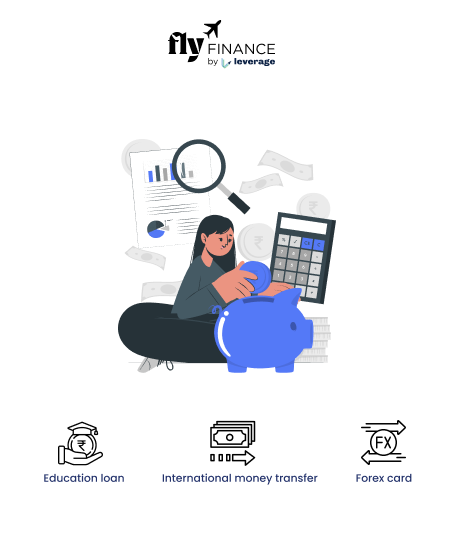Pursuing higher education often comes with significant costs, but a tuition fee waiver can make it more affordable by reducing or eliminating tuition expenses. This financial aid option is especially valuable for students seeking quality education without overwhelming debt.
In this guide, we explore what a tuition fee waiver is, its types, eligibility, benefits, and its role in global education, particularly for international students. Let’s get started!
This Blog Includes:
- What Is a Tuition Fee Waiver?
- Why Tuition Fee Waivers Matter for International Students
- Which Countries Offer Tuition Fee Waivers for International Students?
- Types of Tuition Fee Waivers In India and Abroad
- Tuition Fee Waivers vs. Scholarships vs. Education Loans
- Who Qualifies for a Tuition Fee Waiver?
- How to Apply for a Tuition Fee Waiver
- Top Universities Offering Tuition Fee Waivers
- Benefits and Limitations of Tuition Fee Waivers
- Alternatives If You Don’t Qualify for a Waiver
- How Fee Waivers Affect Financial Aid and Budgeting
- FAQs on Tuition Fee Waiver
What Is a Tuition Fee Waiver?
A tuition fee waiver is a form of financial aid that exempts eligible students from paying part or all of their tuition fees at an educational institution. Unlike scholarships that provide funds or loans that require repayment, a waiver directly reduces tuition costs. Check out the features and purpose below-
- Definition: A tuition fee waiver lowers or eliminates tuition fees for specific courses or programs.
- Scope: It typically covers tuition only, excluding costs like accommodation, textbooks, or administrative fees.
- Purpose: Waivers make education accessible for deserving students, including those with financial constraints or exceptional qualifications.
- Tax Implications: In some regions, waivers may be taxable if they exceed certain thresholds or are deemed non-job-related.
Also Read: What is SIP in Banking & How does it Work?
Why Tuition Fee Waivers Matter for International Students
For students studying abroad, tuition fees can be a major barrier. Tuition fee waivers play a crucial role in making international education accessible and affordable. Let’s highlight the importance of waivers for students pursuing degrees in foreign countries.
- Affordability: Waivers reduce high tuition costs, making prestigious institutions more attainable.
- Access to Excellence: They enable students to enrol in top-tier universities, enhancing academic and career prospects.
- Cultural Diversity: Waivers attract global talent, fostering diverse campus environments.
- Economic Impact: Studying in high-demand fields with waivers can lead to job opportunities in the host country or beyond.
Which Countries Offer Tuition Fee Waivers for International Students?
Countries like the US, Canada, UK, and Germany use tuition fee waivers to ease financial burdens and attract international students. These waivers make their education systems competitive and inclusive. Let’s explore how waivers function in these nations.
- United States: Universities offer merit- or need-based waivers, often for out-of-state or international students, to offset high tuition costs.
For example, the University of Oregon’s ICSP scholarship provides partial tuition waivers (USD 7,500–USD 45,000/year) for international students demonstrating financial need and cultural engagement. - Canada: Institutions provide waivers for specific groups, such as Indigenous or international students in priority fields like STEM Courses.
For example, the University of Ottawa offers a Differential Tuition Fee Exemption Scholarship, reducing international fees to domestic levels (CAD 6,000–CAD 10,000/year) for Francophone students. - United Kingdom: Waivers are tied to government schemes or university programs for economically disadvantaged or high-achieving students.
For example, The University of Sussex offers Chancellor’s International Scholarships, discounting 50% of tuition (GBP 18,000–GBP 22,000/year) for non-EU postgraduate students. - Germany: Public universities charge minimal or no tuition for all students, including internationals, effectively acting as a universal waiver system.
For example, Non-EU students in Baden-Württemberg pay EUR 1,500/semester, but waivers are available for refugees or students with domestic ties.
Types of Tuition Fee Waivers In India and Abroad
Tuition fee waivers reduce or eliminate tuition costs, making higher education accessible for diverse students. These waivers vary by eligibility, purpose, and location, with specialized options for international students studying abroad.
- Merit-Based Waivers: Awarded for academic excellence, such as a GPA above 3.5 or top 10% entrance exam scores.
For example, Bocconi University (Italy) offers full tuition waivers (EUR 14,000/year) for graduate students with outstanding academic records. - Need-Based Waivers: Provided to students from low-income backgrounds, requiring financial proof like income certificates (e.g., family income below USD 30,000/year in the U.S.). Harvard University covers 100% of tuition for families earning less than USD 85,000 annually.
- Category-Based Waivers: Offered to specific groups, such as veterans, employees, or their dependents. In Canada, Queen’s University exempts spouses of foreign military personnel from international fees, saving CAD 20,000–CAD 30,000/year.
- Program-Specific Waivers: Linked to high-demand fields like STEM or education. The University of Toronto offers waivers for STEM programs, reducing fees by up to CAD 15,000/year for international students.
- International Student Waivers: Reduce tuition to domestic levels for qualifying international students. McGill University (Canada) exempts certain international students (e.g., refugees) from international fees, saving CAD 25,000/year.
- Exchange Program Waivers: Cover tuition for students in reciprocal university exchange programs, such as Erasmus+ in Europe, saving EUR 5,000–EUR 15,000/year for participants.
- Government-Sponsored Waivers: Funded by host countries like Germany or the UK to attract talent in fields like technology or healthcare. Germany’s TUM waives EUR 1,500/semester for asylum seekers with high protection quotas.
- University-Specific Waivers: Provided by institutions to enhance diversity or fill specific programs. The University of Dayton (U.S.) offers merit-based waivers up to USD 30,000/year for international students.
Also Read: What is Collateral Security? Meaning, Types & Examples
Tuition Fee Waivers vs. Scholarships vs. Education Loans
Choosing the right financial aid option requires understanding how tuition fee waivers compare to scholarships and education loans. Each has distinct features and implications.
Let’s understand a clear comparison in detail.
| Aspect | Tuition Fee Waiver | Scholarship | Education Loan |
| Definition | Reduces tuition fees | Provides funds for expenses | Borrowed money with interest |
| Repayment | No repayment required | No repayment required | Requires repayment with interest |
| Coverage | Tuition only | Tuition, living costs, or both | Tuition, living costs, or both |
| Eligibility | Merit, need, or category-based | Merit, talent, or need-based | Creditworthiness or co-signer |
| Tax Implications | May be taxable in some cases (e.g., over USD 5,250 in U.S.) | Often tax-free up to a limit (e.g., USD 10,000) | Interest may be tax-deductible |
- Tuition Fee Waivers: Ideal for lowering tuition costs but limited in scope.
- Scholarships: Cover broader expenses but are highly competitive.
- Education Loans: Offer flexibility but require repayment with interest.
Who Qualifies for a Tuition Fee Waiver?
Eligibility for tuition fee waivers depends on specific criteria set by institutions or governments. Meeting these requirements is essential to secure a waiver. The common eligibility conditions for domestic and international students are:
- Academic Excellence: Merit-based waivers require a minimum GPA or high entrance exam scores.
- Financial Need: Need-based waivers demand proof like income certificates or tax returns.
- Group Affiliation: Category-based waivers apply to groups like veterans or employees, requiring documentation.
- Program Enrollment: Some waivers are restricted to specific fields, such as public health or engineering.
How to Apply for a Tuition Fee Waiver
Applying for a tuition fee waiver involves a structured process that varies by institution or country. Following these steps ensures a smooth application.
- Research Opportunities: Explore waiver programs on institution websites or through financial aid offices.
- Gather Documents: Collect academic transcripts, income proof, or category-specific certificates (e.g., veteran status).
- Submit Application: Complete the waiver form accurately and submit by the deadline.
- Follow Up: Track your application and respond promptly to additional requests.
Top Universities Offering Tuition Fee Waivers
Many world-class universities offer tuition fee waivers to attract international students, making high-quality education more accessible. The top institutions known for their waiver programs are:
- Harvard University (US): Provides need-based waivers, covering up to 100% of tuition (USD 54,269/year) for families earning less than USD 85,000 annually.
- University of Toronto (Canada): Offers merit-based and program-specific waivers, reducing international fees by CAD 15,000–CAD 25,000/year for STEM or Francophone students.
- University College London (UCL, UK): Provides waivers through schemes like the Access Opportunity Scholarship, covering GBP 20,000/year for disadvantaged students.
- Humboldt University (Germany): Charges minimal or no tuition (EUR 100–EUR 350/semester) for all students under Germany’s low-tuition policy, saving international students EUR 10,000–EUR 15,000/year.
Benefits and Limitations of Tuition Fee Waivers
Tuition fee waivers offer significant advantages but come with certain restrictions. Let’s explore their pros and cons to help you weigh their value.
Benefits of Tuition Fee Waivers
Waivers make education more affordable and accessible. Key advantages include:
- Reduced Costs: Lowers or eliminates tuition fees, easing financial burdens.
- No Repayment: Unlike loans, waivers require no repayment.
- Accessibility: Enables diverse students to pursue higher education.
- Career Opportunities: Encourages studies in high-demand fields.
Limitations of Tuition Fee Waivers
Waivers have restrictions that may affect their applicability:
- Limited Coverage: Exclude costs like accommodation or textbooks.
- Strict Eligibility: Specific criteria may exclude some applicants.
- Taxable Income: Waivers may be taxable if they exceed certain thresholds.
- Program Restrictions: May not apply to all courses or semesters.
Alternatives If You Don’t Qualify for a Waiver
If you don’t secure a tuition fee waiver, other options can help fund your education. Let’s explore alternatives to manage costs effectively.
- Scholarships: Apply for merit- or need-based scholarships from universities or organizations to cover tuition or living expenses.
- Education Loans: Secure maximum education loan for abroad studies from banks, ensuring you understand repayment terms and interest rates.
- Part-Time Work: Take up on-campus or part-time jobs (subject to visa rules) to offset costs.
- Crowdfunding: Use platforms or seek sponsorships from community groups or employers.
Also Read: Can We Deposit Cash in Any Bank ATM: A Complete Guide
How Fee Waivers Affect Financial Aid and Budgeting
Tuition fee waivers impact your overall financial aid package and budgeting. Here is an explanation how waivers interact with other aid and expenses.
- Financial Aid Impact: Waivers reduce your Cost of Attendance (COA), potentially lowering eligibility for need-based aid.
- Remaining Costs: Budget for fees, accommodation, and other expenses not covered by waivers.
- Tax Considerations: Waivers exceeding certain limits may be taxable, affecting your finances.
- Planning: Combine waivers with scholarships or part-time work to cover non-tuition costs.
A tuition fee waiver is a valuable tool that makes higher education more affordable by reducing or eliminating tuition costs. From merit-based waivers in the US to Germany’s universal low-tuition model, these programs ease financial burdens and attract international students to top universities.
FAQs on Tuition Fee Waiver
A tuition fee waiver is financial aid that reduces or eliminates tuition fees for eligible students, covering specific courses or programs without requiring repayment.
To secure a tuition fee waiver, research university programs in the US, Canada, UK, or Germany. Meet eligibility criteria like academic excellence or financial need, prepare documents (transcripts, income proof), apply early, and follow up. Universities like Harvard offer waivers for qualifying international students.
Yes, Indian students can get tuition fee waivers abroad. Merit-based waivers reward high exam scores, need-based waivers support low-income students, and program-specific waivers target fields like STEM.
A tuition fee waiver reduces tuition costs, lowering your education loan burden. For example, a Harvard need-based waiver cuts tuition significantly, decreasing loan amounts and interest. However, loans may still be needed for accommodation or fees, making waivers a key financial relief tool.
A partial tuition fee waiver, like 50% at Toronto, reduces tuition but leaves remaining costs. You may need a loan for unpaid tuition, accommodation, or fees unless covered by scholarships or savings. Combine waivers with other funding to minimize loan dependency.
A tuition fee waiver lowers tuition costs only, while scholarships may cover tuition, living expenses, or both. Waivers are not repaid, unlike loans.
Eligibility depends on criteria like academic excellence (e.g., high GPA), financial need (e.g., low family income), group affiliation (e.g., veterans), or enrollment in specific programs (e.g., STEM).
Countries like the US, Canada, UK, and Germany offer waivers. For example, Germany’s public universities charge minimal tuition, and the US provides merit- or need-based waivers.
Types include merit-based, need-based, category-based (e.g., veterans), program-specific (e.g., STEM), international student waivers, exchange program waivers, government-sponsored, and university-specific waivers.
Research waiver programs, gather documents (e.g., transcripts, income proof), submit the application by the deadline, and follow up with the institution’s financial aid office.
Benefits include reduced tuition costs, no repayment, increased accessibility to education, and opportunities to study in high-demand fields, enhancing career prospects.
Limitations include coverage limited to tuition (not accommodation or textbooks), strict eligibility criteria, potential tax implications, and restrictions to specific programs or semesters.
To learn more about bank accounts for students, the best education loans, forex, banking experience for global students, or international money transfers, reach out to our experts at 1800572126 to help ease your experience with studying abroad.
Follow Us on Social Media





























